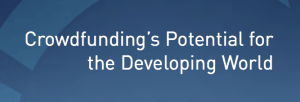 For the better part of a year we’ve been anticipating a report that was to be the product of a joint venture by thought leaders and researchers in the crowdfunding space, distributed and supported by The World Bank. That report, entitled “Crowdfunding’s Potential for the Developing World,” is finally here.
For the better part of a year we’ve been anticipating a report that was to be the product of a joint venture by thought leaders and researchers in the crowdfunding space, distributed and supported by The World Bank. That report, entitled “Crowdfunding’s Potential for the Developing World,” is finally here.
Recognizable names in crowdfunding that contributed to the report include: Sherwood “Woodie” Neiss, Jason Best, Richard Swart, Steve Case, Doug Ellenoff, Judy Robinett and many others.
The report cites the 2008 financial crisis as one of the main catalysts to interest in crowdfunding and specifically equity crowdfunding in the United States. More traditional forms of capital formation clamped down on throughput in the wake of the crisis, creating an even greater need for money to establish new businesses and expand existing ones.
Among many notable revelations contained in the report, one data point is particularly interesting: The United States has 344 crowdfund investing platforms, leading the world in the number of active platforms. The UK is second with 87, and France is third with 53. It is clear that the private market is getting closer to being ready to facilitate deal throughput. (Educational initiatives and the effectiveness of those initiatives is another conversation altogether, but the infrastructure is certainly gearing up if nothing else.)
Another strong theme throughout the document is the importance of trust and transparency in facilitating a healthy crowdfunding sector with wide-ranging participation among potential investors. According to the report, crowdfunding is “a socially mediated phenomenon which relies in great part on the intrinsic trust people place in shared connections on social networks, community affinities, and the ratings of others on trusted, mainstream websites.” Trust between investors is important. Trust between investors and platforms is equally – if not more – important, and that is a challenge crowdfunding platforms of all types will face day-to-day as they try to drive capital from the crowd to those that need it.
The report is 104 pages. Industry participants and true crowdfunding nuts would be well-served by reading the entire document. It dives deep into the ethos of the space and the potential crowdfunding has in regards to leveling the playing field between the developing world and the developed world.
 For those that don’t have time to read the document, we’ve provided what we consider to be the most notable quotes from the document. Call it a TL;DR version…
For those that don’t have time to read the document, we’ve provided what we consider to be the most notable quotes from the document. Call it a TL;DR version…
Developing economies have the potential to drive growth by employing crowdfunding to leapfrog the traditional capital market structures and financial regulatory regimes of the developed world.”
Take: This is the prevailing theme of the entire document. “Diaspora dollars” are regularly cited by Crowdfund Capital Advisors as a potential boon for developing nations. This topic is delved into deeper in later sections, including in this breakdown.
Countries that want to adopt crowdfunding must not only create enabling policy, but also, in some cases, address policies and regulations that currently make it burdensome to enter into, conduct, and end business operations. For example, incorporation or dissolution of a business entity in many developing nations is overly bureaucratic, time-consuming, and costly.”
Take: The success crowdfunding has in facilitating access to capital is only going to be as strong as the culture of entrepreneurship that underlies it. Countries have to facilitate entrepreneurship if they have any hopes of capturing the benefits of crowdinvesting.
The crowdfunding market is in its infancy, especially in developing countries, but the potential market is significant. It is estimated that there are up to 344 million households in the developing world able to make small crowdfund investments in community businesses. These households have an income of at least US$10,000 a year, and at least three months of savings or three months savings in equity holdings. Together, they have the ability to deploy up to US$96 billion a year by 2025 in crowdfunding investments. The greatest potential lies in China, which accounts for up to US$50 billion of that figure, followed by the rest of East Asia, Central Europe, Latin America/the Caribbean, and the MENA region.”
Take: $96 billion per year in deal throughput by 2025 from households in the developing world represents a huge opportunity for growth. It also represents a significant market opportunity, and statistics like this may drive more industry entrants into this niche. Impact investing stands to really explode with crowdfunding.
Today more than 80 percent of the world’s online population interacts with social networks on a regular basis, despite the fact that 65 percent of the world’s population – 4.6 billion people – still lack Internet access (McKinsey Global Institute 2012). Technology-enabled communities, that is, online social platforms that bring the speed, scale, and economies of the Internet to social interactions, have grown to more than 1.5 billion members globally (Curtis, Conover and Chui 2012).
 Take: Social networks are going to be hugely important to the crowdfunding movement. Social media will facilitate interaction and build networks around ideas, entrepreneurs and causes in ways we have never seen before.
Take: Social networks are going to be hugely important to the crowdfunding movement. Social media will facilitate interaction and build networks around ideas, entrepreneurs and causes in ways we have never seen before.
Across all regions, crowdfunding expanded at a 63 percent compound annual growth rate (CAGR) from 2009 through 2012. Equity-based platforms exhibited a CAGR of 114 percent, lending-based platforms 78 percent, donation-based 43 percent, and reward-based 524 percent.
Take: Rewards-based crowdfunding saw a 524% compound annual growth rate between 2009 and 2012. That is amazing. Why? Because it is one of the cheapest and easiest forms of capital formation ever.
When investment decisions are made, a possible exit of that investment should always be contemplated. Crowdfund investments are investments in private companies that lack short-term liquidity, unlike public companies listed on stock exchanges.
Take: Liquidity is a big concern for the crowdfunding space, but the more crowdfunded securities are held the more of an economic case there is for a secondary market. Nobody wants to see day trading in crowdfunding but the opportunity to cash out painlessly may serve the space well. Either way, early on it will be important to educate the public about the lack of liquidity in crowdinvesting.
While an IPO might be the most lucrative exit for a CF investor, the likelihood of a company going public is small in developed countries and even smaller in developing countries.
Take: The public also needs to be realistic about chasing the “big exit.” If that is the public’s focus, the entire industry could suffer for it. Investors would be well-served by seeking investments in companies with long-term, sustainable paths to profitability. (Of course, they’d also be well-served by diversifying and chasing the occasional home run. Just don’t build a portfolio of them.)
To foster an exit, the most logical model for a crowdfund offering would be straight debt or common stock. Common stock could come with anti-dilution preferences that consist of a) buyout of crowdfund shareholders in subsequent rounds at the current price offering, b) ability of crowdfund shareholders to buy in at the price of subsequent rounds or c) an option for crowdfund shareholder to suffer dilution but maintain their shares. Straight debt and common stock are easily understood by investors and offer clearly defined exits.
Take: This is a great breakdown of structure when it comes to crowdfunded securities. Investors are going to want to see an exit, although (again) they must understand that these investments pair companies and investors for what is a relatively long haul when compared to the very liquid public markets.
In the case of crowdfunding, it is important that regulators rethink investor protection given an array of new tools that now are available with the rise of the Internet and the social web.
 Take: Thus far stateside, regulators have done a great job in warning the public of the risks of crowdfunding and crowdinvesting. They’ve done an arguably poor job in tempering that caution with an explanation of the benefits.
Take: Thus far stateside, regulators have done a great job in warning the public of the risks of crowdfunding and crowdinvesting. They’ve done an arguably poor job in tempering that caution with an explanation of the benefits.
The biggest challenge surrounding accreditation is that high income and net worth do not necessarily equate to financial sophistication or knowledge of capital markets.
Consider a movie star and a finance professor: the star probably has far greater net worth and income but a far inferior understanding of capital markets. Nonetheless, when it comes to letting unaccredited investors diversify into crowdfund securities, it is important to set guidelines so that they have an understanding of what are reasonable limits. Models of accreditation should include a consideration of education, to test the investor’s understanding of investment risks, as well as disclosure of experience in investing in general.
Take: This is specifically why accreditation standards in the US are on the cusp of being overhauled. The ability to financially overcome loss of principle is only part of the equation. How educated is the investor? Do they understand the risks?
To streamline bureaucracy and protect private information, individuals should be allowed to self-certify their income or net worth brackets on funding platforms and allow the technology to limit them from going over their investment allocations.
Take: This is exactly what was just rumored in the recent Bloomberg article. Expect this to become a proposed rule.
With equity- and debt-crowdfunding beginning in earnest, there has been a recent acceleration in the number of crowdfunding platforms, particularly in North America, with a 91% increase in 2012.
Take: That is almost twice the platforms year over year. One concern is whether deal throughput will sustain this many platforms, or even a fraction. I expect a big shakeout in the years following the legalization of equity crowdfunding, in particular. Mergers and acquisitions, failures, partnerships… the landscape will change.
Latin America and the Caribbean has seen early hyper growth that exceeds all other regions going from five platforms to 41 since 2010.
Take: Look for the functional effect of this in the coming years. Does this growth lead to a revolution in finance and entrepreneurship in this region?
It is noteworthy that the first significant crowdfunding platform in the developed world was founded in 2008, just two to three years before developing nations began to develop crowdfunding platforms.
Take: It’s still early. Don’t forget it.
Concerns for home country developments and the plight of co-diaspora members in other parts of the world flow from this consciousness and emotional attachment. Crowdfunding may provide a financial outlet for diaspora members’ emotional desires to strengthen their country or population of origin.
Take: In other words, immigrants and distributed pockets of ethnicity will drive funds back to their home countries across the globe, and the reasoning behind that has a foundation in much more than hard ROI.
CFI amplifies friends and family financing by bringing technology to the process of fundraising to make it more scalable and transparent. The entire CFI model is predicated upon the availability of the Internet, social media, and the ability to transfer funds in a “standards-based” way such as mobile payments and online funds transfer.
 Take: Friends and family represent that first-tier network that is so important for any fundraising effort. This is a tale as old as time, but it certainly applies here. The difference is that technology will break down physical barriers to understanding and participation.
Take: Friends and family represent that first-tier network that is so important for any fundraising effort. This is a tale as old as time, but it certainly applies here. The difference is that technology will break down physical barriers to understanding and participation.
The single most predictive factor for the rate of crowdfund emergence is the rate of social media penetration.
Take: To put this another way, social media is one of the most important tools we have in the fight to educate the public about crowdfunding.
At US$93 billion, the potential size of developing world crowdfunding would represent 1.8 times global venture capital investments.
Take: Imagine tripling the throughput of venture capitalists worldwide in ten years. Is it any wonder why there is so much excitement in this space? The question is how do we do so sustainably? Education is so key here. Wide-ranging participation is risky without deep understanding of what it means to participate. This has been seen in the rewards-based space. “We are not a store.”
Data from the major existing platforms show no successful fraud has been perpetrated through pledge-based crowdfunding platforms. Attempts at fraud have been made but were thwarted by the transparency inherent in crowdfunding: would-be investors asked questions and challenged the fraudulent postings, revealing the frauds and resulting in their removal from funding platforms within 24 hours.
Take: This is the one comment I take issue with in the entire report, although it admittedly depends on the definition of “fraud” being applied. Has there never been a rewards-based campaign with material omissions or misinformation? I could cite quite a few examples. Now, the type of fraud where people take the cash and flee to The Bahamas is rare, but that doesn’t mean fraud is rare in a more general sense.
Potential investors need disclosure documents to help them understand these risks, the lack of guarantees, liquidity limitations and other potential pitfalls. In addition to disclosure, CFI portals and trusted third parties should provide robust, easily understood investor educational tools.
Take: Transparency and education is everything. Getting sick of hearing that yet?
Further, Crowdcube, the largest equity-based crowdfunding platform in the United Kingdom, has been operating since February 2011 and has funded 29 companies with more than US$6.75 million, with no reported fraud.
 Take: Yes, fraud in crowdinvesting has been nonexistant. We will see if that persists when global deal throughput increases by a factor of 10. So much of it comes down to crowd wisdom.
Take: Yes, fraud in crowdinvesting has been nonexistant. We will see if that persists when global deal throughput increases by a factor of 10. So much of it comes down to crowd wisdom.
Of the 43,193 projects funded through Kickstarter, there are four documented cases of attempted fraud (Mims 2013).
Take: This is remarkable, although it begs the question of how many go undocumented.
Crowdfunding depends on the existence of an entrepreneurial culture within a country. The literature demonstrates that issues such as culture, legal environment and economic incentives influence the development of industries and the success of entrepreneurial firms. These factors can either constrain or enable entrepreneurial activity. Governments should therefore encourage entrepreneurial culture by supporting initiatives for co-working spaces, incubators and accelerators, mentorship, and so on.
Take: Embrace failure. Consider where funding for a failed company goes: employees and other companies, generally. Even failure can be stimulative. Incubators and accelerators understand this.
One example of the interplay between these institutional arrangements and technological progress can be observed in the United States, where changes in the regulatory arrangements for online investing drove technology innovation and market acceptance. For decades prior to the mid-1990s, investors had to contact a broker by phone or in person to perform a stock or bond trade. The launch of E*Trade transformed this process. For the first time, individuals could perform online transactions that previously were limited to individuals with specific training located in central offices.
Take: Imagine an E*Trade for impact investing or geographic regions. Dare to dream.
The single most important element supporting a healthy entrepreneurial ecosystem is trust – between entrepreneurs, funders, and customers.
Take: For industry participants, consider how you can facilitate that trust. Hint: facilitate conversation and think socially.
Crowdfund investing is unlikely to thrive if social networks do not exist or communities lack “constellations of trust” between members of the community, because investors will not be able to trust that founders will fulfill their promises and create a return on that investment.
Take: See above.
Buying and selling securities is generally a highly regulated activity. Policy makers considering CFI need to strike a balance between regulation and capital formation. A government must be amenable to a structure that at minimum facilitates basic forms of CFI (such as common stock and straight-debt). Such regulation would need to allow companies to incorporate and report the status of their businesses online. To prevent fraud, transactions should take place on platforms that are registered with an oversight body. This framework will channel investments and reduce the appearance of bad actors. The role of vetting opportunities should not fall to regulators, however.
Take: Onerous regulation will only serve to step on any positive net benefit that crowdfunding could provide for all economies. It’s all about balance between capital formation and investor protection. Both are important in their own right, but we can’t sacrifice one in entirety for the other. (Arguably what we’ve been doing in the overlap between the Securities Act and the advent of the Internet.)
Mosaic sold out its first four solar projects in less than 24 hours, attracting more than 400 investors and raising more than US$313,000. The securities sold provide a 4.5 percent annual return, net of service fees, with initial terms of approximately nine years. This project demonstrated the ability of crowdfunding to attract investors for clean energy projects in a short period of time without requiring steep incentives.
Take: Impact investing is going to be big in this space, and Mosaic is a great early bellweather.
[scribd id=283833879 key=key-QYvui2LYgoQmPWlvgJvs mode=scroll]

